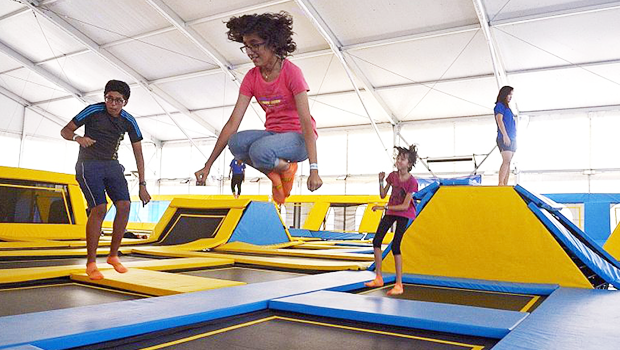
Children in a trampoline park in 2014. A KK Women's and Children's Hospital study has found that soft tissue injuries were the most common type of trampoline-related injuries, followed by fractures and dislocations.ST FILE PHOTO
KKH study finds failed landings make up bulk of such injuries, though most are minor
Recreational trampoline parks have become more popular in Singapore since the first one, Amped Trampoline Park, opened in August 2013.
But while trampolining may be a fun way to work up a sweat, increasing interest in the activity has also led to a rise in the number of children being injured from trampoline-related falls, a local study has found.
More than five trampoline parks have opened here in the past five years, the study noted.
These include Katapult Trampoline Park, SuperPark, Bounce and The Yard.
The Straits Times contacted these parks for comment but did not receive a reply.
In 2013, 17 children under the age of 16 were seen at the emergency department at KK Women's and Children's Hospital (KKH) for such injuries. This rose to 38 cases in 2014 and 49 cases in 2015.
Of the 137 cases seen at the hospital's emergency department between March 2012 and June 2016, more than six in 10 occurred at trampoline parks and the rest at home or at school.
Most injuries, though, were minor and the children were referred to outpatient clinics.
Fewer than 15 per cent required hospitalisation and fewer than 10 per cent required surgery.
The retrospective study that identified cases from the National Trauma Registry was done by Dr Francesca Lim, Dr Vigil James, Dr Lee Khai Pin and Dr Sashikumar Ganapathy, all from the KKH department of emergency medicine.
The findings were published in the Singapore Medical Journal last week.
Failed landings made up the bulk of the injuries, with just over 60 per cent of the accidents resulting from a fall onto the trampoline mat.
More than a quarter of the patients were injured after falling off the trampoline, while another 7 per cent fell and hit the frame of the trampoline. Soft tissue injuries, including contusions, abrasions, lacerations, ligament strains and joint sprains, were the most common type of injuries, followed by fractures and dislocations.
Between March 2012 and June 2016, there were also three instances of head injuries resulting from trampoline-related falls, two of them involving patients below the age of six.
No cervical spine injuries or deaths were recorded.
There were 10 cases where a child was injured while jumping concurrently with another person.
In half of these cases, the children lost balance and fell onto or off the trampoline.
Despite the accidents, the study noted that public trampoline parks here generally have safety rules and features in place to lower the risk of injury. "The safety nets surrounding the periphery of public trampolines may have served their purpose, as only a minority of falls off trampolines occurred in public trampoline parks," the study said.
"Another rule is that children aged below 18 years require a parent or guardian's approval, and all children below four years need to be supervised by an adult.
"Additionally, all users are required to wear grip socks to prevent slipping, and all pockets are to be emptied, with no handheld objects allowed during jumping."
The study recommended that additional safety measures be taken, such as safety education when selling trampolines, ensuring adult supervision, mandatory placement of mats around the periphery of all trampolines and restricting trampoline use to one person at a time.
"Public trampoline parks can also consider increasing the age limit for public trampoline use," the study added.













 Get it on Google Play
Get it on Google Play